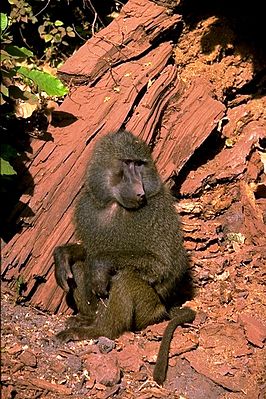Cheek-puff monkey
| Cheek-puff monkey | ||||||||||||
|---|---|---|---|---|---|---|---|---|---|---|---|---|

Anubis baboon ( Papio anubis ) |
||||||||||||
| Systematics | ||||||||||||
|
||||||||||||
| Scientific name | ||||||||||||
| Cercopithecinae | ||||||||||||
| Gray , 1821 |
The cercopithecinae (Cercopithecinae) are a subfamily of the primate family of Cercopithecidae , in the two generic groups ( cercopithecini and papionini ) is divided with a total of twelve species.
distribution
Cercopithecinae are largely in Africa south of the Sahara limited. Only the macaques are found in large parts of Asia as well as in northern Africa and on Gibraltar .
description
The animals get their name from the cheek pouches in which they stow their food and which distinguishes them from the second subfamily of the vervet monkey relatives, the slippery monkey and colobinae (Colobinae). Depending on the habitat, the species differ in terms of body structure. Tree-dwelling species are slender, graceful and have a long tail, ground-dwelling species are rather stocky, and their tail may be diminished or absent. Common to all species are the enlarged canines and the well-developed thumb. Many species have gluteal callosities.
Way of life
Cheekbones monkeys are sociable animals that live together in groups. They are diurnal. Their habitat varies greatly depending on the species, from rainforest inhabitants to animals that live in savannahs to inhabitants of bare rocky areas or even cooler mountains such as the Japanese macaques .
food
Many species are omnivores, their food palette ranges from fruits, leaves, seeds, buds, mushrooms to insects and spiders to smaller vertebrates.
Reproduction
The gestation period lasts around six to seven months before a single young is born. This is weaned after 3 to 12 months and is sexually mature at 3 to 5 years. The life expectancy of some species can be up to 50 years.
Systematics
The cheekbones monkeys are divided into two tribes .
- The vervet monkeys (Cercopithecini) include:
- the around 25 species of the actual monkeys ( Cercopithecus )
- the green monkeys ( Chlorocebus )
- Allochrocebus
- the relatively primitive swamp monkey ( Allenopithecus nigriviridis )
- the pygmy monkeys ( Miopithecus ), which are the smallest Old World monkeys
- the red-colored hussar monkey ( Erythrocebus patas )
- The second group, the baboons (Papionini) include:
- the macaques ( Macaca ), the only genus that lives in Asia and North Africa
- the baboons ( Papio ), which are mostly divided into five types
- the mandrill-like ( mandrillus ), to which the mandrill and the drill belong
- the Gelada or Blood Breast Baboon ( Theropithecus gelada )
- the white-eyed mangaben ( Cercocebus ), which resemble the monkeys
- the black markings ( Lophocebus )
- the 2005 discovered Kipunji monkey or highland monkey , which is classified in its own genus, Rungwecebus
literature
- Thomas Geissmann : Comparative Primatology. Springer-Verlag, Berlin et al. 2003, ISBN 3-540-43645-6 .
- Ronald M. Nowak: Walker's Mammals of the World. 6th edition. Johns Hopkins University Press, Baltimore MD 1999, ISBN 0-8018-5789-9 .